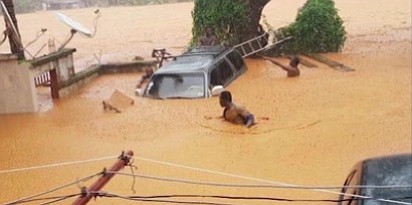More Rhan 300 Bodies Recovered From Sierra Leone Mudslide
CNN/Stylemagazine.com Newswire | 8/16/2017, 9:21 a.m.
By Stephanie Busari and Lauren Said-Moorhouse, CNN
(CNN) -- Rescuers have recovered over 300 bodies following Monday's deadly mudslide on the outskirts of Sierra Leone's capital, the country's tourism minister said Wednesday.
Sidie Tunis told local radio that 297 bodies have been brought to the overwhelmed city morgue at the Connaught Hospital, including those of 105 men, 83 women and 109 children. A further seven bodies were found at the site on Wednesday morning, raising the death toll to 304 people, Colonel Abubakarr Bah, who is leading recovery operations, told CNN.
Around 600 people are still unaccounted for after heavy rains struck the Regent district in the early hours of Monday morning, causing torrents of mud to wash down Mount Sugar Loaf about five miles outside the capital Freetown, according to government officials and aid agencies.
Houses that hugged the slopes, many of them little more than wooden shacks with tin roofs, were buried after a chunk of the mountain came down under the force of the water.
Numbers are expected to rise as search and rescue efforts continue for a third day in one of the deadliest natural disasters to hit Africa in recent years. A mass burial is planned for Wednesday and Thursday in an effort to free up space in the struggling mortuaries.
Between 2,000 and 3,000 people have been displaced, Abu Bakarr, spokesman for the Red Cross in Sierra Leone, told CNN on Tuesday.
Prayers at site
At noon on Wednesday, the country came to a standstill for a minute's silence to honor those who died in the tragedy.
Bishop John Yambasu, head of the United Methodist church, led prayers from the scene of the mudslide. He had come to visit the site to pay his respects where a congregation had held an overnight vigil.
"We have been through 10 years of war, then Ebola and now this. Have mercy on Sierra Leone, Father," he intoned.
James Chifwelu, national director of the charity World Vision in Sierra Leone, described the scenes as "heartbreaking," with the "sounds of wailing and mourning everywhere" as rescuers continue to work against the clock to pull survivors from the rubble.
Many residents of the hilltop community were still asleep in their beds when the disaster hit.
"It's disturbing that so many lives have been lost following this heavy rain and mudslide," Chifwelu said.
"But it's most disturbing that many children in their school uniforms were unfortunately fatally caught up in the landslide and many more are homeless, orphaned and will be without food and clothing for days to come. This certainly calls for immediate action.''
Many still coming to terms with disaster
Save the Children staff member Ramatu Jalloh was near the scene as the tragedy unfolded.
"We were driving on the main road out of Freetown past Regent when a lady ran onto the road and started gesticulating wildly. She called out to another lady who had been riding a bike in front of us who, after a brief conversation, started crying and looked very upset," she said.
"It was clear from their reactions that something terrible had happened. Soon afterward, another man ran towards our car. He was crying about the number of lives that had been lost.
"As we continued down the road we could see there was a serious issue. Tons of water was rushing across the road, splitting it in half. We contacted the Save the Children office immediately to tell them that something was seriously wrong."
President Ernest Bai Koroma toured the ravaged Regent district on Tuesday. His spokesperson told CNN that social-welfare teams have been deployed to "ascertain exactly how many people are missing."
He added that a Sierra Leonean and a Chinese construction company had provided heavy-duty excavation equipment to help the military looking for people under the mud and rubble.
Flooding is not unusual in the region, which is currently experiencing its rainy season.
But this year has been particularly wet, with Freetown receiving more than 27 inches of rain between July 1 and Aug. 13 -- more than double the average of 11.8 inches, according to the US National Weather Service's Climate Prediction Center.









